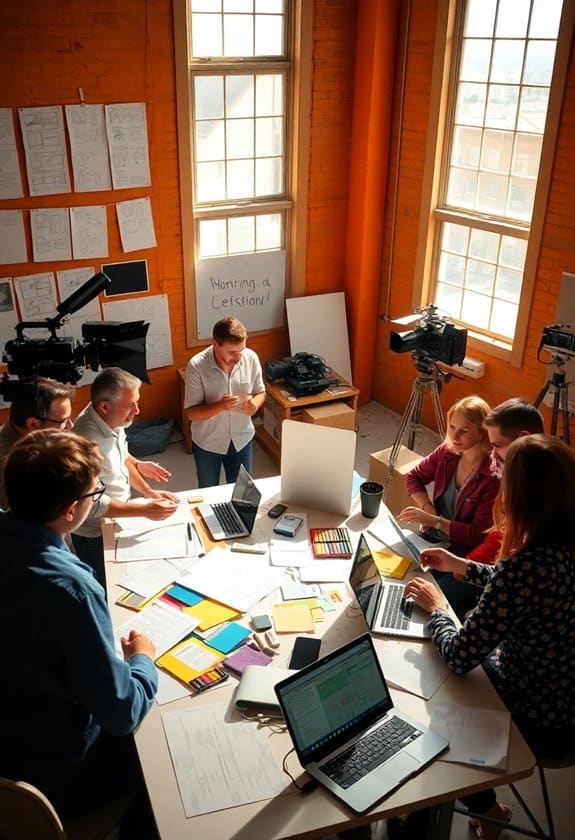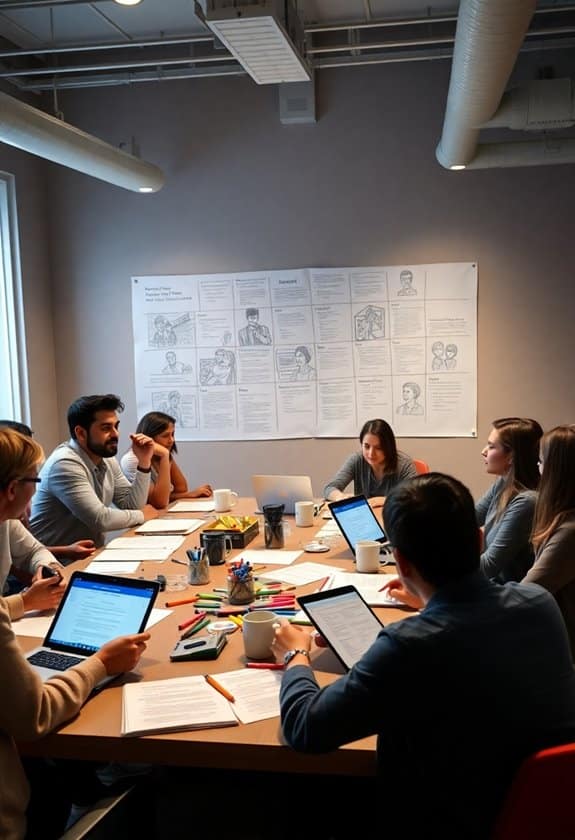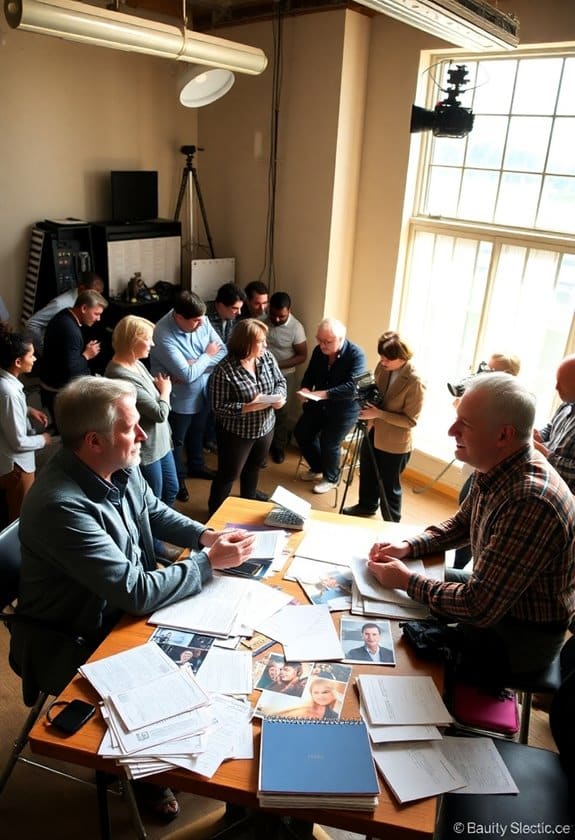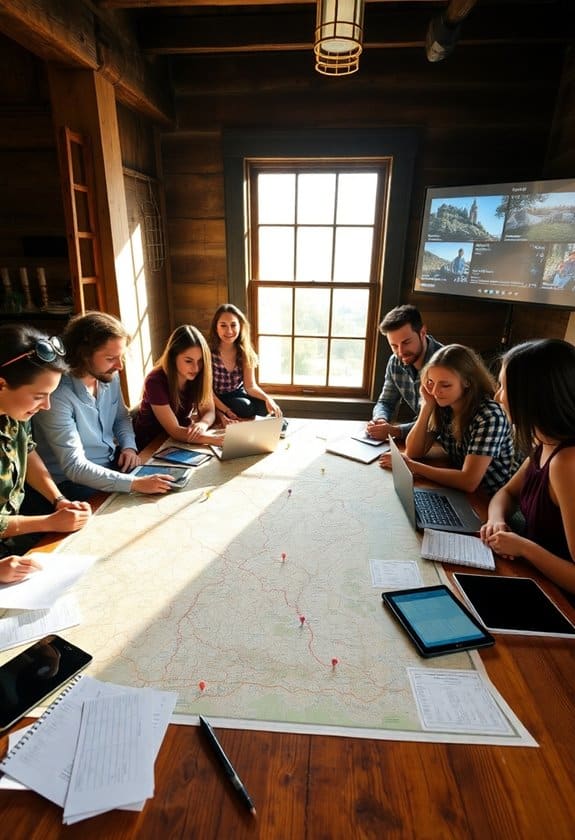Pre-production is like the ultimate playlist preparation before a big concert—you’ve got to get everything right! It’s where you map out every detail, from budget plans to casting, just like assembling the perfect team for a quest. Imagine the chaos of filming with no budget or half the crew missing; that’s why this stage is critical. I once scrambled for locations under a ticking clock because we hadn’t scouted early—lesson learned! Crafting a solid script during this phase guarantees everyone marches to the same beat. Stick around to discover more secrets to mastering this pivotal phase.
Important Highlights
- Pre-production is the stage where projects are meticulously planned to prevent chaos during execution.
- It involves budgeting to ensure financial resources are aligned with the creative vision.
- Location scouting is crucial for finding safe, thematic spaces for shooting.
- Casting and crew selection impact production quality and set dynamics.
- Script development lays the narrative foundation for the entire production process.
Understanding Pre-Production Basics

Pre-production is the vital stage that lays the groundwork for any successful project, whether it’s a film, a play, or a video game. You might think of it as the project’s blueprint. It’s where you plan every detail to guarantee everything runs smoothly and safely.
Imagine building a giant LEGO set without instructions—chaos, right? That’s why pre-production is essential.
When I worked on my first short film, I underestimated this stage. I thought, “How hard can it be?” But without a solid plan, we ran into tons of problems, like missing props and confused cast members.
Trust me, you don’t want that kind of stress. So, take the time to map out your project. It mightn’t seem thrilling, but it’s your safety net.
Key Elements of Pre-Production

What Is Pre-Production and Why It Matters?
Key Elements of Pre-Production
Having grasped the basics of pre-production, it’s time to focus on the key elements that make this stage effective. This part of filmmaking is all about setting the stage safely, so everything feels like a well-rehearsed dance.
Think of it as gathering all the puzzle pieces before you start the picture. Here are the key elements you need to take into account:
- Budget Planning: Guarantees you’ve got enough cash to bring your vision to life without unexpected surprises.
- Location Scouting: Finding safe and suitable places to shoot that match your creative ideas.
- Casting: Choosing the right people who’ll bring characters to life.
- Equipment Selection: Picking the right tools to capture your story safely, including essential filmmaking equipment that enhances organization and efficiency.
- Scheduling: Organizing timelines to keep everything on track.
The Role of Script Development

At the heart of any successful film is a well-developed script that serves as its blueprint.
Imagine building a house without a clear plan—it’d be a disaster! A script is your film’s safe foundation, guiding every decision.
You’ve got to nail this first step because it shapes everything else. I once tried to rush through script development, thinking I could wing it. Big mistake! The scenes felt scattered, and the story was confusing.
So, take your time, brainstorm ideas, and refine them until they’re as polished as a diamond. Trust me, a solid script makes the rest of the process way smoother.
It’s like having a trusty map that keeps you on track, ensuring your film’s journey is safe and rewarding.
Importance of Casting and Crew

A film’s success hinges not only on a great script but also on the perfect casting and crew choices.
Imagine picking actors who bring characters to life and a crew that works like a well-oiled machine. It’s kind of like choosing the right puzzle pieces; when they fit, everything clicks.
Here’s why it’s essential:
- Safety and Trust: A reliable team guarantees a safe environment on set.
- Expertise: Skilled professionals make everything look and feel just right.
- Chemistry: A harmonious cast and crew create a positive vibe.
- Problem-Solving: Quick thinkers can tackle any unexpected hiccups.
- Passion: Enthusiastic individuals push the project toward success.
Planning Locations and Budget

With the right cast and crew in place, the next step is choosing where to bring your story to life and guaranteeing the finances are in check.
It’s like finding that perfect spot for a picnic—comfort and safety are key. You’ll want to scout locations that match your script’s vibe, keeping logistics in mind. Is it safe for everyone involved? Consider how the weather might affect your plans. You don’t want a rainstorm interrupting your sunny beach scene!
Budgeting is like planning a road trip: you’ve got to know where every dollar is going.
Break down costs for locations, permits, and unexpected surprises. Having a solid budget guarantees you won’t run into financial roadblocks, keeping your production on track and everyone feeling secure.
Frequently Asked Questions
How Does Pre-Production Impact the Overall Success of a Film or Project?
Oh sure, just skip pre-production and see how well that works, said no successful filmmaker ever!
Do you want a safe, smooth sailing project? Plan it out! Pre-production is like your project’s safety net. You’re organizing, budgeting, and scheduling, which feels like adulting, but hey, it’s necessary.
Imagine directing without a plan; chaos, right? I remember my first film—forgot to plan a scene. Never again!
Pre-production guarantees you’re ready for anything.
What Are Some Common Challenges Faced During the Pre-Production Phase?
During pre-production, you might face challenges like coordinating everyone’s schedules, which can feel like herding cats!
Ensuring safety on set is vital, so you’ll need to plan for risks, like bad weather or equipment issues.
Budgeting can also be tricky; it’s easy to overspend if you’re not careful.
Storyboarding may seem intimidating, but it’s essential for clarity.
Don’t forget to communicate well with your team—it’s the glue that holds everything together!
How Can Technology Be Utilized to Streamline the Pre-Production Process?
Did you know that using digital tools can cut pre-production time by up to 30%? It’s pretty cool!
Imagine using apps like Trello or Final Draft to organize scripts and storyboards safely. You won’t lose important papers or worry about messy handwriting.
Plus, video calls make meetings a breeze, so you’re not running around town! These tools make everything smoother and more fun, just like a superhero with a really organized cape!
What Role Does Pre-Production Play in Risk Management for a Project?
Pre-production is like your superhero cape when it comes to risk management. Imagine planning a big party—without it, things could get chaotic!
In filmmaking, pre-production helps you spot potential problems before they crash the scene. You’ll create budgets, scout locations, and plan logistics to guarantee safety and success.
Think of it as your project’s safety net, catching issues before they happen. When risks are managed early, you’re free to focus on creating something amazing!
How Do Filmmakers Ensure Effective Communication During Pre-Production?
Imagine communication during pre-production like a conductor leading an orchestra, ensuring harmony and preventing chaos.
You’ll want to use tools like storyboards and shot lists to keep everyone on the same page, literally.
Don’t forget regular meetings—think of them as team huddles, where you can address concerns and adjust plans.
Clear communication is your safety net, preventing misunderstandings and ensuring that everyone’s vision aligns, just like a well-rehearsed symphony.



